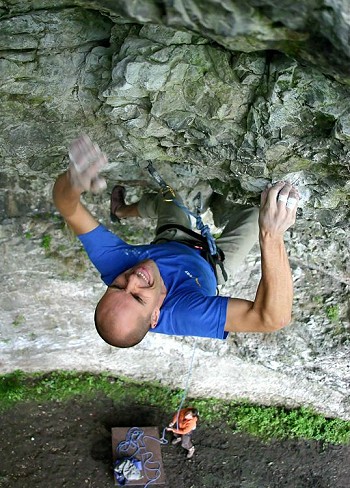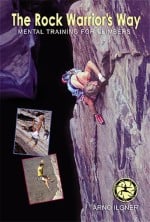

It would seem as if Craig was being mentally tough by staying focused on the goal and not letting fear or the pump distract him; yet, that mental toughness resulted in a terrible fall and barely escaping a serious injury. When we think of being mentally tough we envision someone whose mind has power over one's body. It's a mind over matter approach. We envision the climber staying committed to the goal without giving in to the desire to quit.
This mind-over-matter approach caused Craig's mind to perceive the situation as he wished it to be, not as it actually was. With a mind-over-matter approach you rely on what your mind knows from past experience. This can be helpful to a degree in doing risk assessment, but it can interfere with perceiving the situation as it is now. This is what happened to Craig. He had climbed Zoo View before. He engaged Zoo View the second time with mental perceptions that he was “absolutely sure where the route went” and that “it wouldn't be difficult.” Both of these perceptions were wrong. He was getting feedback from the situation (the route and his body) telling him that he was off route and too pumped for committing to a no-fall section. His mind, however, still attached to the old perceptions, ignored this feedback and tried to distort the situation to fit its perceptions. He then engaged an inappropriate risk and fell.
Mental flexibility, conversely, allows you to stay receptive to the feedback you get from a situation. The fact that a situation is stressful indicates that learning needs to take place. Learning converts stress into comfort. In order to do this conversion you need to take in the stress, accept it, and process yourself through it. Doing this requires flexibility, not toughness. You don't distort the situation to fit your mind's perception of it, but rather let go of your mind's perception to see the situation as it is now. You do this in a matter-over-mind, not a mind-over-matter, approach. By engaging your body (matter) and keeping attention on the tasks your body is doing to climb, you allow your mind to accept and process the stress. What is required is to keep attention on the current task. Attention shouldn't be on thinking about the climbing. This will lead to reinforcing the existing mental construct and enhance toughness not flexibility. Attention should simply be immersed in what your body is doing to climb.
Risk Assessment
Mental toughness can lead to taking inappropriate risks because the end goal can interfere with assessing the situation effectively. Mental flexibility allows you to take appropriate risks. When you are stopped at a stance, assess the situation, and then make a decision that will lead to taking an appropriate risk.
Climbing has “no-fall” and “yes-fall” risks. You determine appropriateness differently for each of these. In no-fall risks you weigh the strength, skill, and confidence you have left, compared to what is left to climb, in order to pass through the difficulties and not fall. You usually climb more slowly, stay on routes below your technical ability, and you do listen to your mind when it determines you can't or shouldn't continue.
In yes-fall risks you weigh the fall consequence you face—length of fall, obstacles, etc.—against your actual experience taking such falls. You climb more quickly, get on routes at or above your technical ability, and you don't listen to your mind when it says you can't continue.
A primary part of mental flexibility is determining what type of risk you are in and then engaging accordingly. Many climbs have both yes- and no-fall zones. You could be on a runout trad climb, like Zoo View, that you'd label no-fall but has yes-fall zones close to solid pro. Or, you could be on a sport climb that you tend to think of as yes-fall but has sections where a fall could cause injury, like climbing to the first or second bolt or where the bolts are farther apart. Being mentally flexible means you do assessment several times on a climb and then engage accordingly. Mental toughness doesn't have the flexibility to adapt to these distinctions.
Craig had climbed Zoo View before without much difficulty so it was within his technical difficulty. But the second time he was off route, not knowing it at the time, facing a no-fall situation in a state of fatigue. His mind, however, insisted that he was on route and ignored the feedback his body and the climb were giving him. His mind was tough and rigid, clinging to its false perceptions. After taking a Warrior's Way course Craig learned how to be mentally flexible. He learned that the risk on Zoo View was no-fall and not appropriate to engage when the chance of falling was great. He also learned options he could have acted on based on the feedback he was getting from the situation. Doing this would keep him from being drawn in by the justifications of his mind. He could have down-climbed to his last stance to regroup and reassess. He could have rested at his current stance to regain strength. Doing this would have allowed him to see if he could collect enough strength to climb the no-fall section without falling. Or, he could have looked for more pro where he was, to convert the no-fall section into a yes-fall section. All of these flexible options would have been based on what was actually happening on the climb, not based on mental justifications about what should be happening. Matter (the body and the climb) directs the mind on how pumped you are, whether you face a no-fall or yes-fall section, and how to engaged based on the type of risk it is. Then the mind simply needs to stay flexible as the body engages appropriately. Climbing in a matter-over-mind approach allows you to keep attention fully on the task, based on the type of risk.
Mental toughness tends to force the mind's current perceptions onto the climb—a mind-over-matter approach. Mental flexibility keeps the mind's limiting perceptions from interfering with the feedback the body is currently experiencing—a matter-over-mind approach. Craig learned effective risk assessment for challenging climbs that he applied while taking the Warrior's Way course. Most important, though, he learned the value of staying mentally flexible so he could process whatever happens on the climb to insure he engages appropriate to the risk and still performs at his best.
His book The Rock Warrior's Way: Mental Training for Climbers is available from his websiteThe Warrior's Way and from Amazon
- Deliberate Transitions are Ambiguous - Mental Training 8 Jul, 2008
- Learning How to Learn.... to Fall 29 Apr, 2008
- Motivation Justification 16 Apr, 2007
- Learn to Expect; Expect to Learn 27 Apr, 2006
- No Expectations 20 Jan, 2006
- Why Are You Taking a Risk? 7 Oct, 2005
- Feeling Safe is Dangerous 2 Sep, 2005









Comments